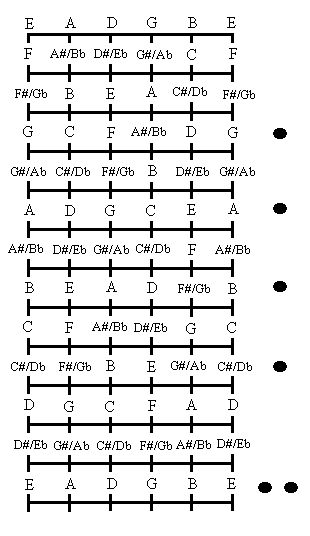
During my time teaching I have often been suprised when I have met new students who, although they have been playing for quite some time, do not know the names of the notes on the fingerboard.
The fact is, if you want to be a better guitarist, you really have got to know your way around the neck. Without worrying about the accented notes (the ones with 'sharp' or 'flat' in their names) have a look at the arrangement of notes on the guitar neck in standard tuning:
 |
The diagram has the 'dot' markers down
the right-hand side in the same way as most guitars do -
this should help you to keep track of the position up the
neck. There are a couple of important things to notice here: Firstly, after 12 frets, the note names repeat themselves (notes at the 12th fret are one octave above the open strings). Also, the 1st and 6th strings are both tuned to an E, so the names of the notes on these strings are the same all the way up the neck. There is an interval of two octaves between the open low E and the open high E. |
Of course, there are notes in the 'blank' spaces in this first diagram. Naming these is simple enough, they can be referred to as either the lower note with a sharp (#) sign after it, or as the higher note with a flat (b) sign after it. Check out this view of the fingerboard:
 |
This might look a bit cluttered, but
basically it's the same as the first diagram, but it has
the 'blanks' filled in. Whether a note gets referred to as, for example, A# or Bb is very often governed by the rules (or guidelines) of music theory. There'll be some more information in these pages later, but don't worry about it too much for now. Just concentrate on learning the location of the notes on the fingerboard. |
(Just out of interest,in standard tuning the bass guitar is the same as the bottom four strings of the guitar, but one octave lower)
Remember, although you might be able to play purely by ear, you'll only really be able to apply yourself to the guitar if you understand how scales and chords fit together, and the different ways that you can play them on the instrument. Stick at it and get to know the fingerboard - it's probably the most valuable thing that you'll ever learn on the guitar. Good luck!
How useful did you find this tutorial?
| Product/Info... | PhatPhish Application | | | Product Help | | | GUPPY - PhatPhish for the web | | | About The Author |
|---|
| Get Stuff... | Download PhatPhish | | | Mechandise | | | Blank Stave And Tab Sheets | | | Tutorials |
|---|
| Do Stuff... | Register | | | Feedback | | | Links | | | Donate | | | Ask A Question |
|---|
| Social Media... | YouTube | | | | |
|---|
| Promote... | Spread The Word | | | Posters/Flyers |
|---|
| Play... | PhatPhish Picks - Boutique Plectrums |
|---|
| ©2002-2022, Dave Dixon / CyberFlotsam http://www.cyberflotsam.com |